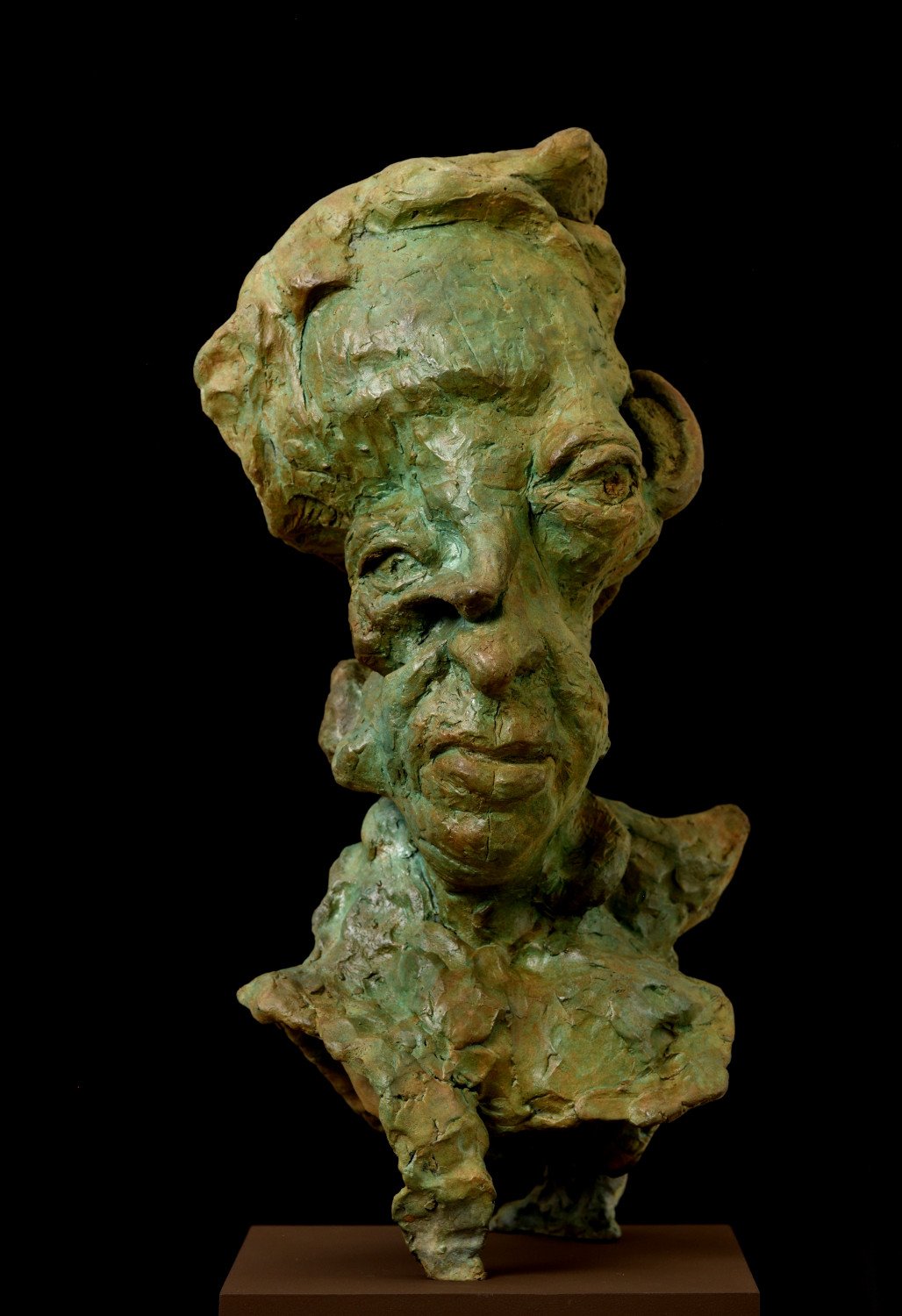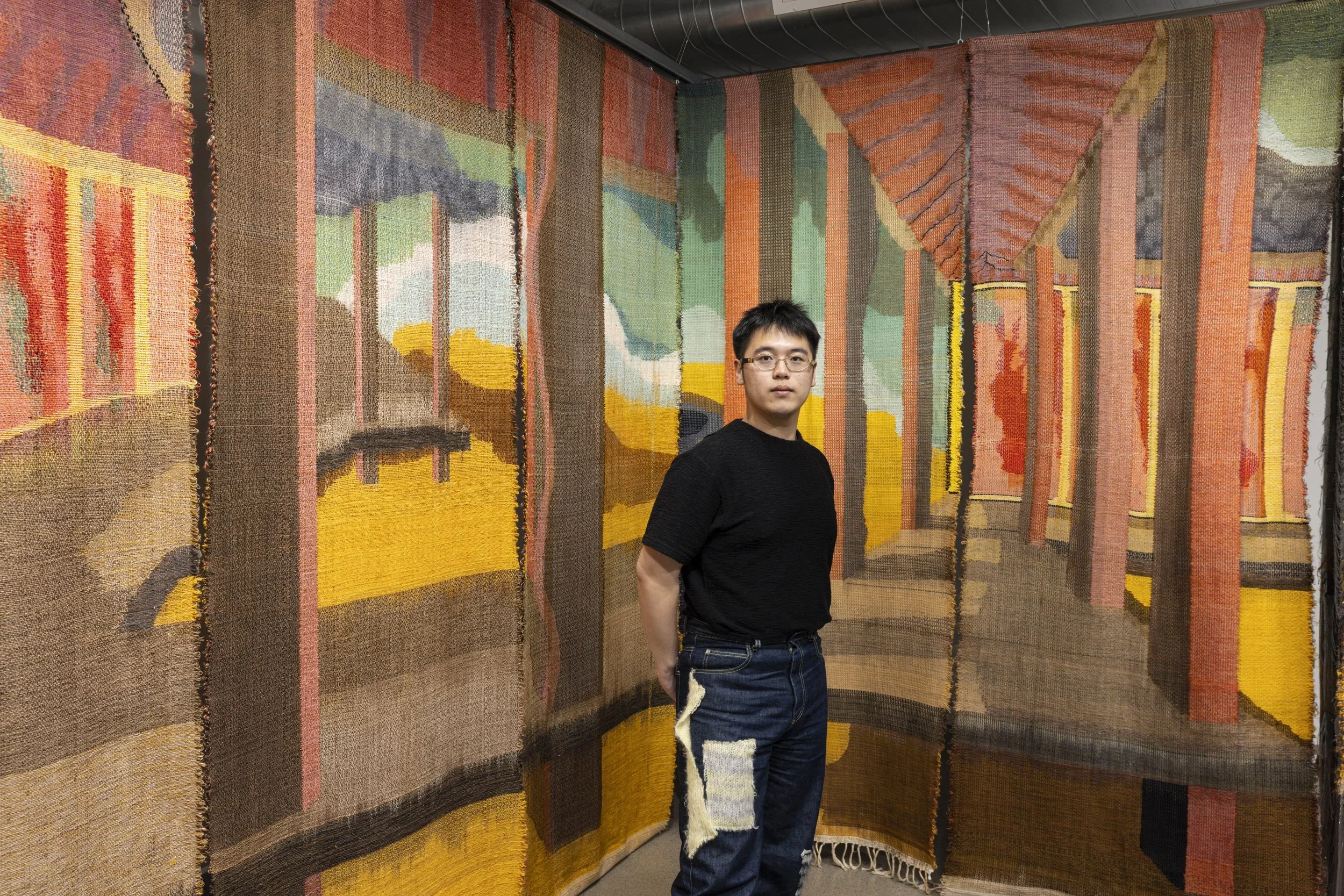Dr Gindi, Kant and the Encounter with the Sublime
A passionate thinker, notwithstanding being a grounded sculptor, Dr Gindi reflects a lot on the connection between philosophy and the arts. And she triggers a debate that echoes and emphasizes this connection in her work, a debate that emphatically ties with Immanuel Kant’s understanding of the Sublime. Apart from their stunning appeal, Dr Gindi’s sculptures ask the viewer to mirror the grammar of consciousness, investigate a core sense of sublimity outside of decay, and contemplate about infinite presence. Daringly swimming against the tide of contemporary art, and taking such arts along untrodden paths, Dr Gindi’s work is all-embracing and ranges across legacies of aesthetic thought at the same time as it includes introspections that are profound and often surprising.
Dr Gindi Portrait | Photo courtesy braschler/fischer
INTERVIEW with Al-Tiba9
Curated by Mohamed Benhadj
Your art is deeply influenced by Western philosophy, and you often reference philosophers like Plato or Kant. But let's take a step back and start from the beginning. What does beauty mean for you? And how can we objectively define beauty?
I don't shy away from mentioning beauty when speaking about art and life in general. I am not using the word in some principled manner, but rather to explain a moment of surprise, satisfaction, and, yes, happiness – beauty is not a dead issue to me. Let me explain what I mean by referring to a special moment I experienced once in the morning. It was after a long winter that suddenly and ostensibly, springtime arrived. When I went to my garden, I stared at my cherry tree, fully in blossom. The tree was always there, but now after months in darkness, it showed me its luscious splendor. Almost a voluptuous, seductive, erotic magic. I was dazzled as beauty appeared so sensually and unexpectedly. And I dreamt that everything – subject or object – could be notable, that bloom like that could be everywhere. Everything could contain beauty and perhaps experience the sublime of an infinite void—an undetermined and sometimes even unnecessary beauty. There was a feeling of felicity as a gateway to the sublime experience that originates when indulging in space, a feeling which was and still is just there, based on the pulsating expense of infinity.
Back to my studio, inspired by the belief in a nature pervaded by the divine, I modeled and completed a sculpture within only a few hours – a work I called The Horticulturist. I was deeply satisfied with the result, if I may say so. As it just happened in an untamed manner, modeled with my hands, organically forming bits of clay, adding and subtracting, I was in an almost poetic mode of how much I venerate the earth's allure.
With this sculpture, I envisioned an enlightened gardener who is germinating trees, shrubs, and flowers with his infinite self, launching a universal inquiry into the existential arousal of infinity and its tonic value; infinity as a metaphor for having the bravery to seize the unprecedented and to allow it to unfurl. But is the sculpture beautiful as well, for its own sake? I don't know, you have to decide - I don't think about beauty when I work. Beauty is floating, and it is in the eyes of the beholder. It is a very empathetic pleasure.
The Horticulturist, Bronze, 51x25x22 cm, 2021 © Dr Gindi
As a sculptor yourself, how did you get involved with philosophy, and how do you apply aesthetics to your art?
I like to sculpt, all day long. And I guess you realize already that I am not a traditional aesthete. I do not relish in Apollonian views of what beauty ought to be. Or what contemporary art ought to be, embodied in the context of verifiable judgments. These views unceasingly exclude certain kinds of work, especially non-mainstream or, on the contrary, too traditional. And all too often, the beautiful remains a synthetic construct and a common characteristic to all things that go by one name.
I should say that I like dissonant beauty. Or beauty that doesn't explain itself. Here the complexity of philosophical reasoning is manifested: when the appearance is discomposed by an impact from the outside, or an inner rebellion, or even a battle with the dark side of humanness. Take, for example, one of my recent works, called Fear is Hunting You: Draped in chains and wielding a projectile, an amorphous character stalks its prey, his hooded countenance conveying the sense of an invisible imminent threat. Discomfort is given a face. An ugly face? Most people might say that this nameless creature is not a pretty character. In contrast to the idealized beauty of contemporary art – and the glossy irony carried with it in many cases, my works are often fragmented, splintered, and distorted. Instead of referring to a Platonic world, where forms are refined to perfect apotheosis, I am more engrossed in presenting the fluidity of being in a fractured world – a reality that is, in all likelihood, characterized by dissonance, porosity, and decay.
Beauty seems to be a rather subjective experience for you, especially considering your interpretation of Plato. How can something subjective become admired by a plurality of persons?
As I see it, the emphasis of Plato was on the profound penetration of truth. The visual manifestation of truth reveals itself in an ideal beauty that resides in the domain of forms. For Plato, beauty is always something objective, it is not about the perception of the beholder. Although I agree with Plato on many other accounts, I am starkly at variance with him on his conception of beauty. As a visual pragmatist, I passionately believe that beauty does not lie in things but is rather subjective, a matter of emotions. I agree instead with Immanuel Kant, who argued that aesthetic judgments are based on feelings, notably the feeling of pleasure. In his Critique of Judgment, Kant introduces the human mind as an active initiator of experience rather than a passive designatory of perception.
In other words, and if I understand Kant correctly, the most compelling thing about beauty is not the outcome but the ephemeral, the ever-flowing allure that does not come to a close. Like in my sculpture Sancta's Broken Halo, where I show a young woman wearing an injured nimbus of light. She might have experienced a rift in her life, but now she looks into the future from the vantage point of a soul that is radiating bliss – Sancta is sparkling with gold. Many observers told me that they were strangely moved when looking at the sculpture. Some seem to experience a sort of beauty that holds the world together in its inmost folds. Sancta's fondness of infinity is perhaps palpable and an aesthetic experience of pure pleasure. I would even contend that art can be a prism through which beauty flows, inciting perhaps a certain sublime experience. But let me also argue that aesthetics and ethics are better kept apart – with my own work, at least, I don't want to tell viewers what is good and what is bad. I just want to inspire and present a work that is moving.
Sancta's Broken Halo, Bronze, 58x46x34 cm, 2021 © Dr Gindi
You mentioned Immanuel Kant, which seems to be a rather poignant fit for your art. In his Critique of Judgment, Kant introduced sublimity in addition to beauty. How much has this concept influenced your art?
While Kant's moral and epistemological philosophy had stayed on the philosophical radar throughout time, rather little has been considered in Kant's aesthetics. Let me dive here a bit deeper: Kant calls sublime that which is absolutely elevated, beyond human understanding - something metaphysically and actually greater than ourselves, dexterously quivering beyond what we are able to conceive. The sublime is certainly a heightening of the beautiful – as the beautiful is merely something pleasurable to us. The sublime, on the other hand, is to be found in infinite presence; its totality is also breathing in the world of ideas. Speaking with Kant, the sublime is limitless so that we can freely levitate in our fluidity of being.
Let me exemplify the idea of the sublime with the sculpture Transfigured Immortality – showing a graceful lady in the prime of her life, leaning on her last place of rest. She reflects upon her existence, rimmed by scattered light glistening from the deep. By accepting the world beyond, she illuminates her present life in sublime awe. It is not exanimate eternal life but the lightness of infinite presence that I try to capture in that sculpture.
Kant speaks a lot about temporality and our existence within the world as temporal beings. When I sculpt ideas like immortality that is transfigured, I do this as they are visually tied into imagination and how we relate to it. The sublime transcends all time and – in full consequence – the spaces that condense our form and foam.
One of the fascinating aspects of your art is how it engages with the enigma of infinity. For those less familiar with your work, it may be described as a dynamic synthesis of body and soul, as an ontological union of the physical and mental. Could you tell us more about how this profound inquiry into infinity defines the aesthetics you have been developing? What is the relationship between the Infinite and the Sublime?
How something looks has no infinity. How it is and how it has been is true infinity. That's the unique attribute of the sublime over the beautiful. And the reason why I identify the sublime as the experience of the infinite. Look at In Reverie, my latest work: A seated female figure leans forward in contemplation of a flower she is holding in her hand. She purses her lips to blow the flower's petals into the air, suggesting an intimate connection to the cycle of being and the cosmos beyond, granting her the speculative thought of the infinite. This oneiric instant encapsulates the limitless potential of the imagination to sow and cultivate the invisible life that nurtures our soul. The figure in In Reverie is not a beauty queen, but she might be full of sublimity, beckoning us to allow ourselves to linger and breathe in the blissful sensation of infinity. The sublime, in this scenario, is not just a privilege but also a meaningful indicator of humanness, even humility, as encountered in its infinite presence.
With my work, I want to offer release from the self-referential thrownness into the world, transporting us beings into a state of gentle being, a mood that is unconditional. Ultimately, there is also blazing ardor, like a promise longing for sensual transformation. Infinity, in the end, is an experience of ourselves. It cannot be defined or reduced to beauty. Coming back to In Reverie: The protagonist is probably addressing us, inviting us to follow in her footsteps by relying on our inner compass to guide us as we forge the way to an expansive experience of the infinite self. Conceivably, she is entranced with the sublime infinity she perceives to be within her grasp.
In Reverie, Aluminium, 35x20x35 cm, 2022 © Dr Gindi
After such an interesting dive into your art and philosophy, let's circle back to the first question. Do you think aesthetic judgments have any objective truth value? And would it be a better world if we could all agree on what is beautiful and what is sublime?
The search for the sublime infinite is the deepest human challenge, and art is perhaps its best response. Re-invoking the Kantian distinction between beauty and the sublime, I don't have much of a normative claim. My approach shall be purely respectful as I am withdrawn from the sort of aesthetics that tries to define what art is and what is not. As a matter of fact: I am not here to propose judgments of any kind – my sculptures shall speak for themselves. It is up to everyone and all of us to decide on beauty and sublimity. Knowing that the sublime makes infinity palpable, I create sculptures that live and breathe, recollect and reveal, leaving us potentially with an unforgettable experience. All I can do is keep on trying.





















